Keeping up with the Morohoshis: Buying a bomb shelter in Tokyo suburbs

FILE PHOTO: Megumi Morohoshi, a Japanese mother of three, poses for a photo outside her family’s newly installed bomb shelter in Saitama, Japan December 5, 2022. REUTERS/Adroniki Christodoulou
TOKYO — When North Korea lofted a missile over Japan in September, setting off emergency alerts across cell networks, Megumi Morohoshi made a decision: she was going to buy a bomb shelter.
Morohoshi had been concerned about the ever-present danger from Japan’s earthquakes, and she had been wanting to expand the house to accommodate her three young children.
But the invasion of Ukraine followed by a barrage of North Korean missiles convinced her the threat was urgent.
“When the alert went off, that was really scary,” Morohoshi, 40, said as she sat on the floor of the narrow, solid-steel box that occupies the parking spot of her home.
“I’d always wanted a room like this, but then in October I made up my mind that I needed to hurry up and buy one.”
Article continues after this advertisementIn the shadow of the political tension, the Morohoshi family have joined the small but growing number of Japanese who are taking security into their own hands.
Article continues after this advertisementSome reached out to Nao Engineering, which has been selling its Crisis-1 shelters since Dec. 2021, but saw a surge in inquiries after Russia’s invasion of Ukraine in February.

FILE PHOTO: Megumi Morohoshi, a Japanese mother of three, displays the stores of emergency food inside her family’s newly installed bomb shelter in Saitama, Japan December 5, 2022. REUTERS/Adroniki Christodoulou
Even after more than 70 years, memories persist in Japan of intense bombing during World War II, including the only atomic detonations in combat.
And the nuclear specter revived recently, after Russian President Vladimir Putin threatened to use “all means” in his nation’s defence.
In Asia, concerns persist that China could try to seize the self-governed island of Taiwan, which it claims as its own.
The year’s most active threat to the Japanese archipelago has been North Korea, which launched dozens of missiles and is said to be preparing for its first nuclear test since 2017.
One of its projectiles sailed over Japan in October, for the first time in five years. And the following month an intercontinental ballistic missile (ICBM) landed just 200 km (130 miles) from the northwestern coast.
Nao’s shelters, about the size of a large walk-in closet, are made of iron, with lead plating to withstand all but a direct hit from a missile or nuclear blast, while an Israeli-made filtration system will keep out radiation or dangerous gas.
But that protection comes at a price.

FILE PHOTO: Megumi Morohoshi, a Japanese mother of three, poses for a photo inside her family’s newly installed bomb shelter in Saitama, Japan December 5, 2022. REUTERS/Adroniki Christodoulou
The shelters, custom-built at Nao’s factory in Ibaraki prefecture, north of Tokyo, cost 6 million yen ($44,000) before installation expenses. And the three-tonne boxes are too bulky to fit in the vast majority of Japanese homes or yards.
Nao’s managing director, Yoshimitsu Koyano, thinks Japan is sorely unprepared for the risk of bombardment.
His company has received orders for nine shelters, about half from individuals and the rest from agencies, to be used for exhibition purposes, he added.
Every day in the absence of apocalypse, the Crisis-1 can be used as a hobby room, a child’s study area, or a home office, a brochure says.
Morohoshi’s unit, delivered late last month, is an austere white box with “CRISIS-01” emblazoned on the side, with external cameras mounted on it. It juts out of the bottom of their narrow three-story home in Saitama.
The neighbors have not asked about it, she said, but her children call it a “secret base” to play in, while she can escape a noisy home to read or study there.
And in an emergency, her family of five can hunker down for as long as a week without having to leave behind their beloved hedgehog.
“You can’t take pets with you to public shelters,” she said. “But for pet owners, being able to shelter together brings peace of mind.”